Budgeting and Financial Analysis: CRC and Patricia Eklund Cases Study
VerifiedAdded on 2022/09/24
|11
|2654
|25
Case Study
AI Summary
This document presents a comprehensive analysis of two case studies focused on budgeting and financial management. The first case, Case 9-45, examines the City Racquetball Club (CRC) and its adoption of a new membership plan and fee structure. The analysis explores the impact of these changes on cash receipts, cash flow, and financial planning, considering factors such as annual membership fees and hourly court fees. It evaluates the factors CRC must consider during the implementation of the new membership plan, including customer reactions, implementation costs, and financial analysis methods like balance sheets and income statements. The second case, Case 9-46, focuses on participative budgeting, evaluating its benefits and deficiencies within the context of Patricia Eklund's policy. It examines the behavioral benefits of participative budgeting, such as employee motivation and a sense of ownership. The analysis identifies deficiencies in Eklund's policy, including accountability for unfavorable performance, the handling of expenditures, and the role of higher authority in specific projects, offering recommendations for improvement.

Running head: BUDGETING
Budgeting
Name of the Student
Name of the University
Author Note
Budgeting
Name of the Student
Name of the University
Author Note
Paraphrase This Document
Need a fresh take? Get an instant paraphrase of this document with our AI Paraphraser
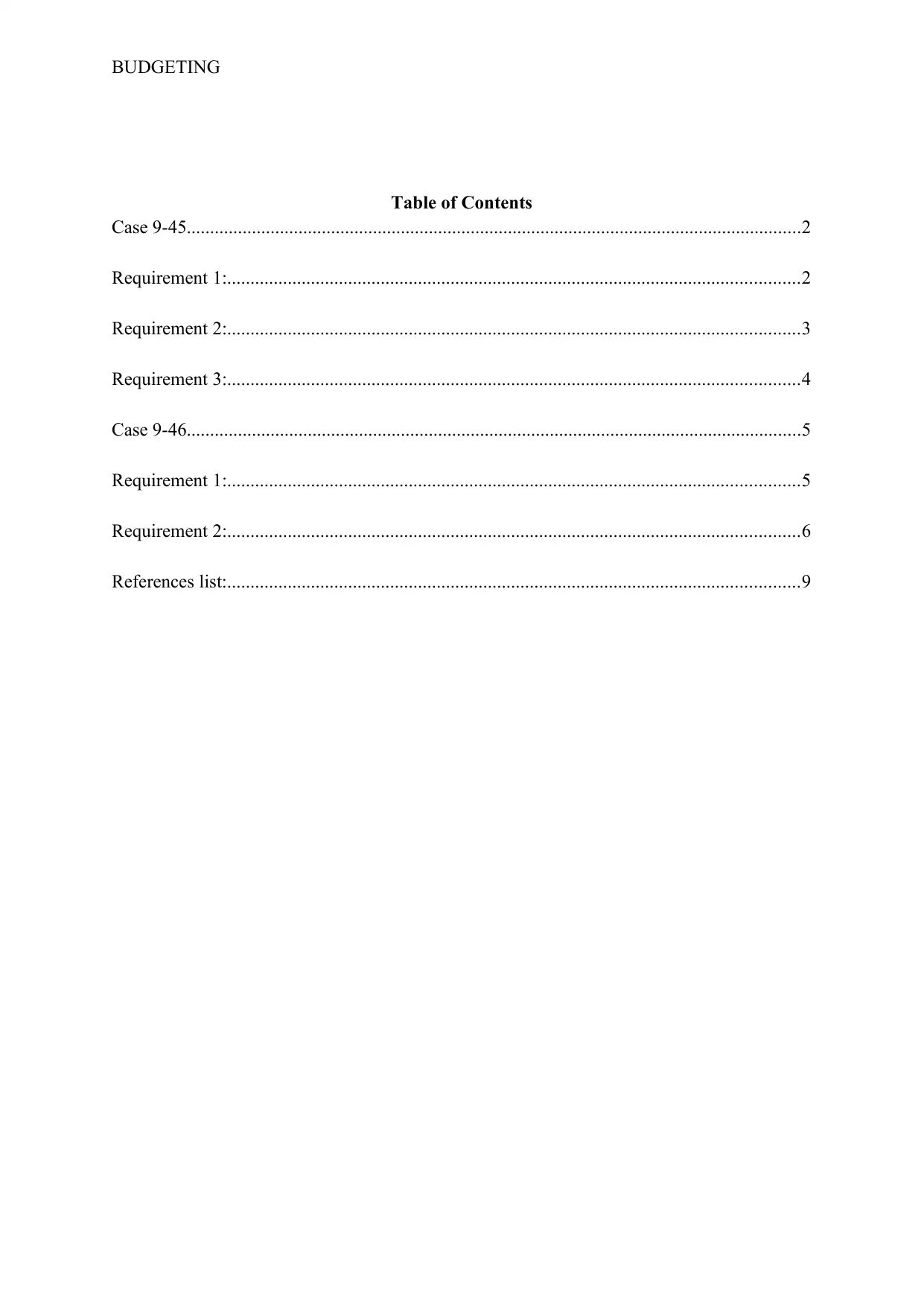
BUDGETING
Table of Contents
Case 9-45....................................................................................................................................2
Requirement 1:...........................................................................................................................2
Requirement 2:...........................................................................................................................3
Requirement 3:...........................................................................................................................4
Case 9-46....................................................................................................................................5
Requirement 1:...........................................................................................................................5
Requirement 2:...........................................................................................................................6
References list:...........................................................................................................................9
Table of Contents
Case 9-45....................................................................................................................................2
Requirement 1:...........................................................................................................................2
Requirement 2:...........................................................................................................................3
Requirement 3:...........................................................................................................................4
Case 9-46....................................................................................................................................5
Requirement 1:...........................................................................................................................5
Requirement 2:...........................................................................................................................6
References list:...........................................................................................................................9
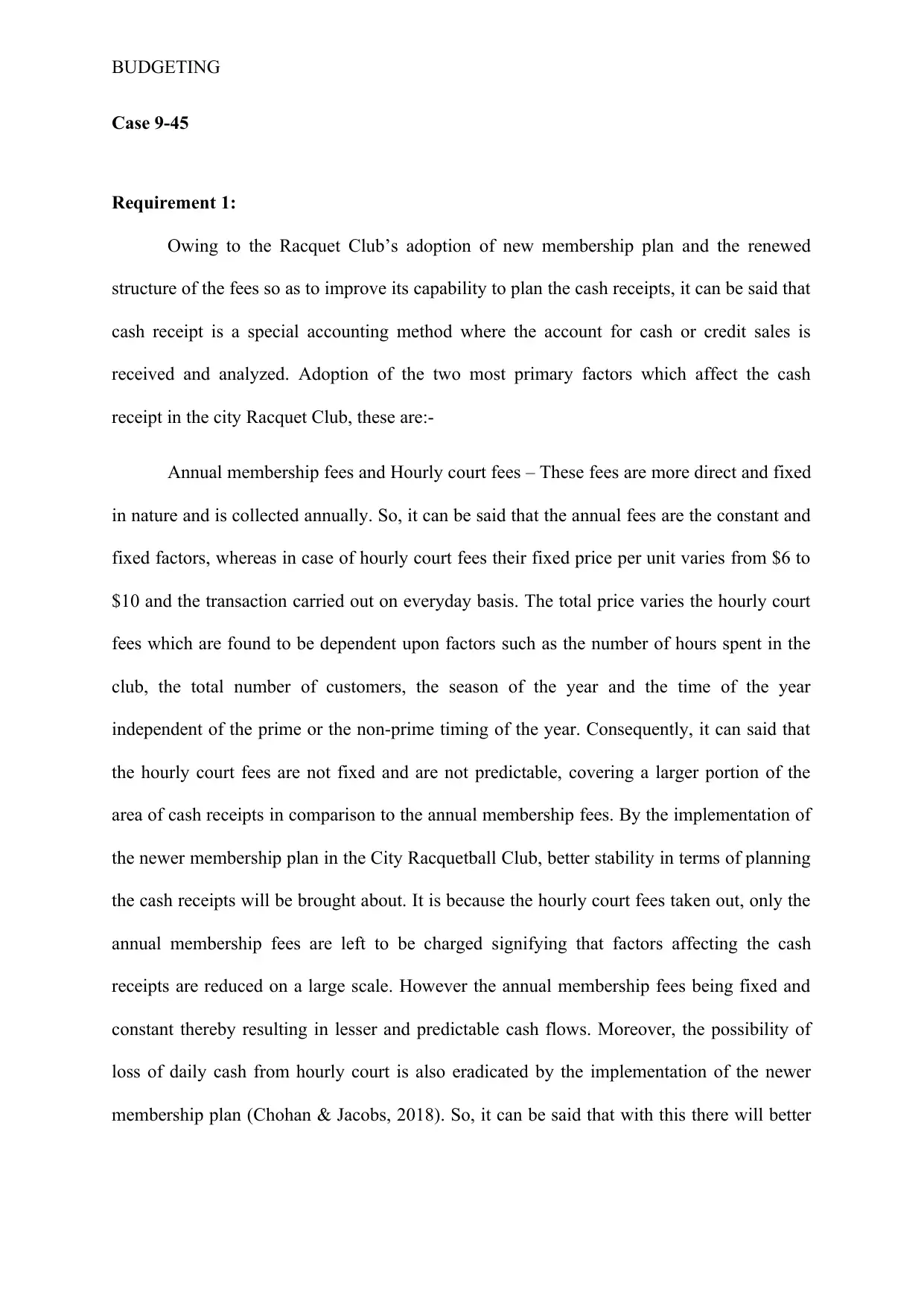
BUDGETING
Case 9-45
Requirement 1:
Owing to the Racquet Club’s adoption of new membership plan and the renewed
structure of the fees so as to improve its capability to plan the cash receipts, it can be said that
cash receipt is a special accounting method where the account for cash or credit sales is
received and analyzed. Adoption of the two most primary factors which affect the cash
receipt in the city Racquet Club, these are:-
Annual membership fees and Hourly court fees – These fees are more direct and fixed
in nature and is collected annually. So, it can be said that the annual fees are the constant and
fixed factors, whereas in case of hourly court fees their fixed price per unit varies from $6 to
$10 and the transaction carried out on everyday basis. The total price varies the hourly court
fees which are found to be dependent upon factors such as the number of hours spent in the
club, the total number of customers, the season of the year and the time of the year
independent of the prime or the non-prime timing of the year. Consequently, it can said that
the hourly court fees are not fixed and are not predictable, covering a larger portion of the
area of cash receipts in comparison to the annual membership fees. By the implementation of
the newer membership plan in the City Racquetball Club, better stability in terms of planning
the cash receipts will be brought about. It is because the hourly court fees taken out, only the
annual membership fees are left to be charged signifying that factors affecting the cash
receipts are reduced on a large scale. However the annual membership fees being fixed and
constant thereby resulting in lesser and predictable cash flows. Moreover, the possibility of
loss of daily cash from hourly court is also eradicated by the implementation of the newer
membership plan (Chohan & Jacobs, 2018). So, it can be said that with this there will better
Case 9-45
Requirement 1:
Owing to the Racquet Club’s adoption of new membership plan and the renewed
structure of the fees so as to improve its capability to plan the cash receipts, it can be said that
cash receipt is a special accounting method where the account for cash or credit sales is
received and analyzed. Adoption of the two most primary factors which affect the cash
receipt in the city Racquet Club, these are:-
Annual membership fees and Hourly court fees – These fees are more direct and fixed
in nature and is collected annually. So, it can be said that the annual fees are the constant and
fixed factors, whereas in case of hourly court fees their fixed price per unit varies from $6 to
$10 and the transaction carried out on everyday basis. The total price varies the hourly court
fees which are found to be dependent upon factors such as the number of hours spent in the
club, the total number of customers, the season of the year and the time of the year
independent of the prime or the non-prime timing of the year. Consequently, it can said that
the hourly court fees are not fixed and are not predictable, covering a larger portion of the
area of cash receipts in comparison to the annual membership fees. By the implementation of
the newer membership plan in the City Racquetball Club, better stability in terms of planning
the cash receipts will be brought about. It is because the hourly court fees taken out, only the
annual membership fees are left to be charged signifying that factors affecting the cash
receipts are reduced on a large scale. However the annual membership fees being fixed and
constant thereby resulting in lesser and predictable cash flows. Moreover, the possibility of
loss of daily cash from hourly court is also eradicated by the implementation of the newer
membership plan (Chohan & Jacobs, 2018). So, it can be said that with this there will better
⊘ This is a preview!⊘
Do you want full access?
Subscribe today to unlock all pages.

Trusted by 1+ million students worldwide

BUDGETING
cash flow and this will also draft out future financial plans like shortage of cash will be more
effective. However this will not affect the overall profit of City Racquetball club.
Requirement 2:
a. There are some primary factors which the CRC must take into account during the
evaluation and adoption of the new membership plan and fee structure completely. One of the
most significant factor is on how the existing or new customers would react to the price
changes which might give rise to another factor like the loss or gain to the company. As the
newer membership structure is already taking in the risks of losing its customers, as because
the customers on paying a higher annual membership fees might compare with the
competitors of the City Racquet Ball club. Therefore the club must provide more benefits in
comparison to their competitors.
Another most important factor is the overall cost during the implementation of the
new membership plan this process of changeover must be properly evaluated. Proper
planning must be done prior evaluation so that there is no unreasonable hike in the price. In
order to achieve a lean changeover the City Racquetball Club must reduce the cost to a
certain extent. While the implementation of the new fee structure the club must consider key
factors such as extra frontline training on new prices, customer handling, new packages and
other possible queries arising among the customers. The staff must be proactive and notify
their customers about every detailed changes brought about in their club and all the
information regarding the briefed over the renewed implementations as producing accounts
for end of year checks with new prices and packages can be perplexing. Another important
factor in analyzing is if the implementation will result in earn or loss. The major inflow of
cash of this club is from the consumers purchasing the hourly court fees and the annual
membership fees. This analysis of these factors shall help in including how the new
cash flow and this will also draft out future financial plans like shortage of cash will be more
effective. However this will not affect the overall profit of City Racquetball club.
Requirement 2:
a. There are some primary factors which the CRC must take into account during the
evaluation and adoption of the new membership plan and fee structure completely. One of the
most significant factor is on how the existing or new customers would react to the price
changes which might give rise to another factor like the loss or gain to the company. As the
newer membership structure is already taking in the risks of losing its customers, as because
the customers on paying a higher annual membership fees might compare with the
competitors of the City Racquet Ball club. Therefore the club must provide more benefits in
comparison to their competitors.
Another most important factor is the overall cost during the implementation of the
new membership plan this process of changeover must be properly evaluated. Proper
planning must be done prior evaluation so that there is no unreasonable hike in the price. In
order to achieve a lean changeover the City Racquetball Club must reduce the cost to a
certain extent. While the implementation of the new fee structure the club must consider key
factors such as extra frontline training on new prices, customer handling, new packages and
other possible queries arising among the customers. The staff must be proactive and notify
their customers about every detailed changes brought about in their club and all the
information regarding the briefed over the renewed implementations as producing accounts
for end of year checks with new prices and packages can be perplexing. Another important
factor in analyzing is if the implementation will result in earn or loss. The major inflow of
cash of this club is from the consumers purchasing the hourly court fees and the annual
membership fees. This analysis of these factors shall help in including how the new
Paraphrase This Document
Need a fresh take? Get an instant paraphrase of this document with our AI Paraphraser
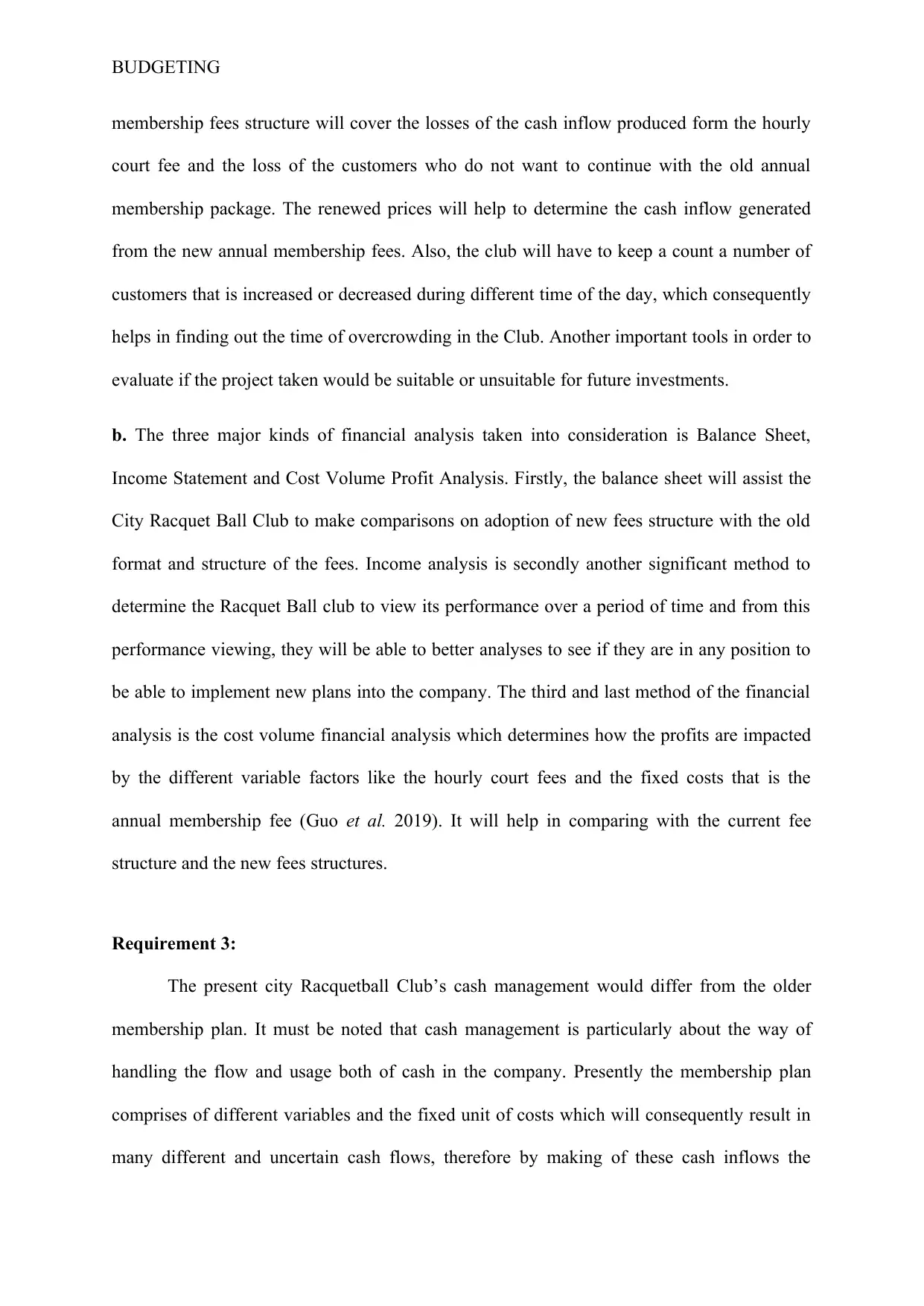
BUDGETING
membership fees structure will cover the losses of the cash inflow produced form the hourly
court fee and the loss of the customers who do not want to continue with the old annual
membership package. The renewed prices will help to determine the cash inflow generated
from the new annual membership fees. Also, the club will have to keep a count a number of
customers that is increased or decreased during different time of the day, which consequently
helps in finding out the time of overcrowding in the Club. Another important tools in order to
evaluate if the project taken would be suitable or unsuitable for future investments.
b. The three major kinds of financial analysis taken into consideration is Balance Sheet,
Income Statement and Cost Volume Profit Analysis. Firstly, the balance sheet will assist the
City Racquet Ball Club to make comparisons on adoption of new fees structure with the old
format and structure of the fees. Income analysis is secondly another significant method to
determine the Racquet Ball club to view its performance over a period of time and from this
performance viewing, they will be able to better analyses to see if they are in any position to
be able to implement new plans into the company. The third and last method of the financial
analysis is the cost volume financial analysis which determines how the profits are impacted
by the different variable factors like the hourly court fees and the fixed costs that is the
annual membership fee (Guo et al. 2019). It will help in comparing with the current fee
structure and the new fees structures.
Requirement 3:
The present city Racquetball Club’s cash management would differ from the older
membership plan. It must be noted that cash management is particularly about the way of
handling the flow and usage both of cash in the company. Presently the membership plan
comprises of different variables and the fixed unit of costs which will consequently result in
many different and uncertain cash flows, therefore by making of these cash inflows the
membership fees structure will cover the losses of the cash inflow produced form the hourly
court fee and the loss of the customers who do not want to continue with the old annual
membership package. The renewed prices will help to determine the cash inflow generated
from the new annual membership fees. Also, the club will have to keep a count a number of
customers that is increased or decreased during different time of the day, which consequently
helps in finding out the time of overcrowding in the Club. Another important tools in order to
evaluate if the project taken would be suitable or unsuitable for future investments.
b. The three major kinds of financial analysis taken into consideration is Balance Sheet,
Income Statement and Cost Volume Profit Analysis. Firstly, the balance sheet will assist the
City Racquet Ball Club to make comparisons on adoption of new fees structure with the old
format and structure of the fees. Income analysis is secondly another significant method to
determine the Racquet Ball club to view its performance over a period of time and from this
performance viewing, they will be able to better analyses to see if they are in any position to
be able to implement new plans into the company. The third and last method of the financial
analysis is the cost volume financial analysis which determines how the profits are impacted
by the different variable factors like the hourly court fees and the fixed costs that is the
annual membership fee (Guo et al. 2019). It will help in comparing with the current fee
structure and the new fees structures.
Requirement 3:
The present city Racquetball Club’s cash management would differ from the older
membership plan. It must be noted that cash management is particularly about the way of
handling the flow and usage both of cash in the company. Presently the membership plan
comprises of different variables and the fixed unit of costs which will consequently result in
many different and uncertain cash flows, therefore by making of these cash inflows the
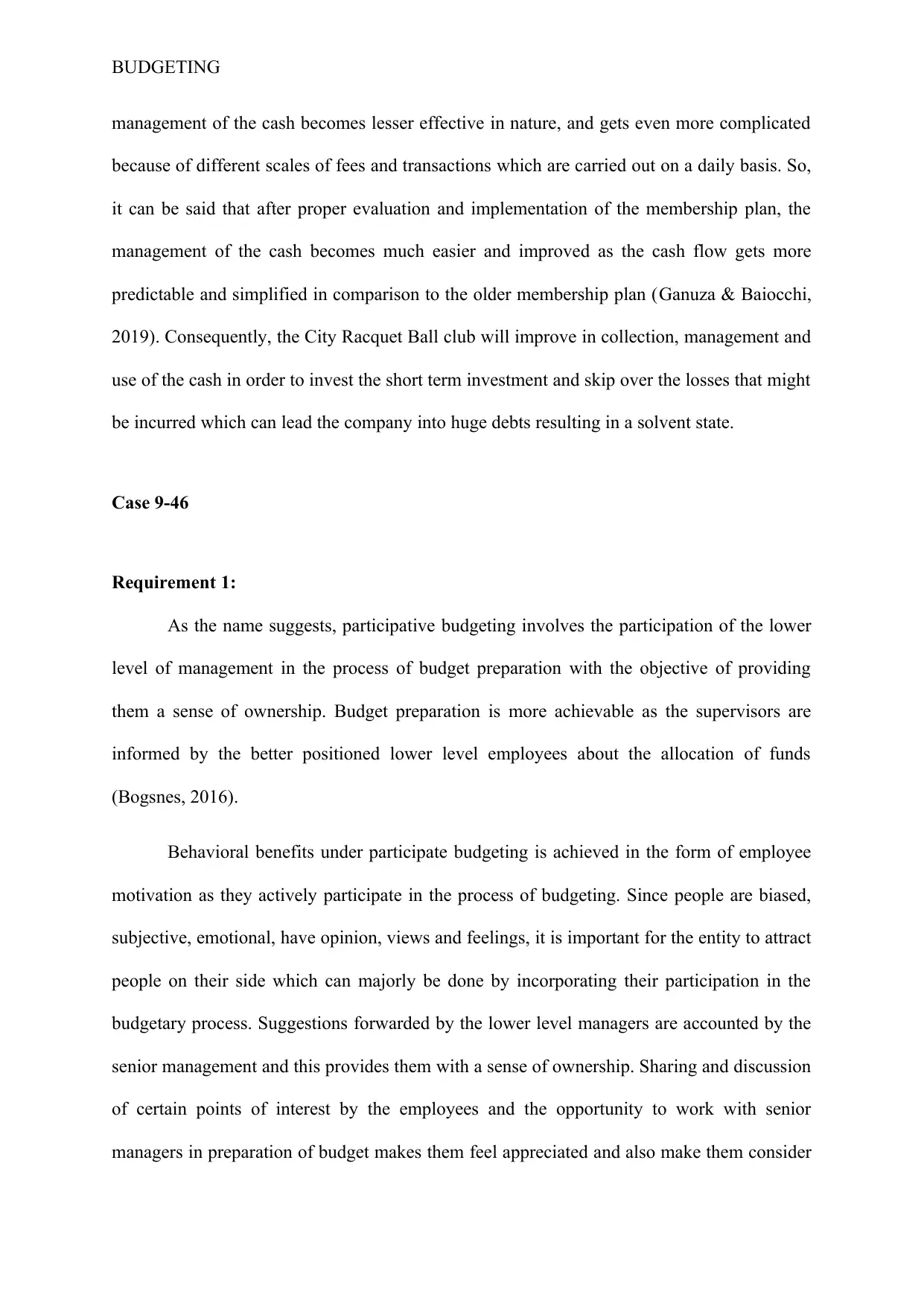
BUDGETING
management of the cash becomes lesser effective in nature, and gets even more complicated
because of different scales of fees and transactions which are carried out on a daily basis. So,
it can be said that after proper evaluation and implementation of the membership plan, the
management of the cash becomes much easier and improved as the cash flow gets more
predictable and simplified in comparison to the older membership plan (Ganuza & Baiocchi,
2019). Consequently, the City Racquet Ball club will improve in collection, management and
use of the cash in order to invest the short term investment and skip over the losses that might
be incurred which can lead the company into huge debts resulting in a solvent state.
Case 9-46
Requirement 1:
As the name suggests, participative budgeting involves the participation of the lower
level of management in the process of budget preparation with the objective of providing
them a sense of ownership. Budget preparation is more achievable as the supervisors are
informed by the better positioned lower level employees about the allocation of funds
(Bogsnes, 2016).
Behavioral benefits under participate budgeting is achieved in the form of employee
motivation as they actively participate in the process of budgeting. Since people are biased,
subjective, emotional, have opinion, views and feelings, it is important for the entity to attract
people on their side which can majorly be done by incorporating their participation in the
budgetary process. Suggestions forwarded by the lower level managers are accounted by the
senior management and this provides them with a sense of ownership. Sharing and discussion
of certain points of interest by the employees and the opportunity to work with senior
managers in preparation of budget makes them feel appreciated and also make them consider
management of the cash becomes lesser effective in nature, and gets even more complicated
because of different scales of fees and transactions which are carried out on a daily basis. So,
it can be said that after proper evaluation and implementation of the membership plan, the
management of the cash becomes much easier and improved as the cash flow gets more
predictable and simplified in comparison to the older membership plan (Ganuza & Baiocchi,
2019). Consequently, the City Racquet Ball club will improve in collection, management and
use of the cash in order to invest the short term investment and skip over the losses that might
be incurred which can lead the company into huge debts resulting in a solvent state.
Case 9-46
Requirement 1:
As the name suggests, participative budgeting involves the participation of the lower
level of management in the process of budget preparation with the objective of providing
them a sense of ownership. Budget preparation is more achievable as the supervisors are
informed by the better positioned lower level employees about the allocation of funds
(Bogsnes, 2016).
Behavioral benefits under participate budgeting is achieved in the form of employee
motivation as they actively participate in the process of budgeting. Since people are biased,
subjective, emotional, have opinion, views and feelings, it is important for the entity to attract
people on their side which can majorly be done by incorporating their participation in the
budgetary process. Suggestions forwarded by the lower level managers are accounted by the
senior management and this provides them with a sense of ownership. Sharing and discussion
of certain points of interest by the employees and the opportunity to work with senior
managers in preparation of budget makes them feel appreciated and also make them consider
⊘ This is a preview!⊘
Do you want full access?
Subscribe today to unlock all pages.

Trusted by 1+ million students worldwide
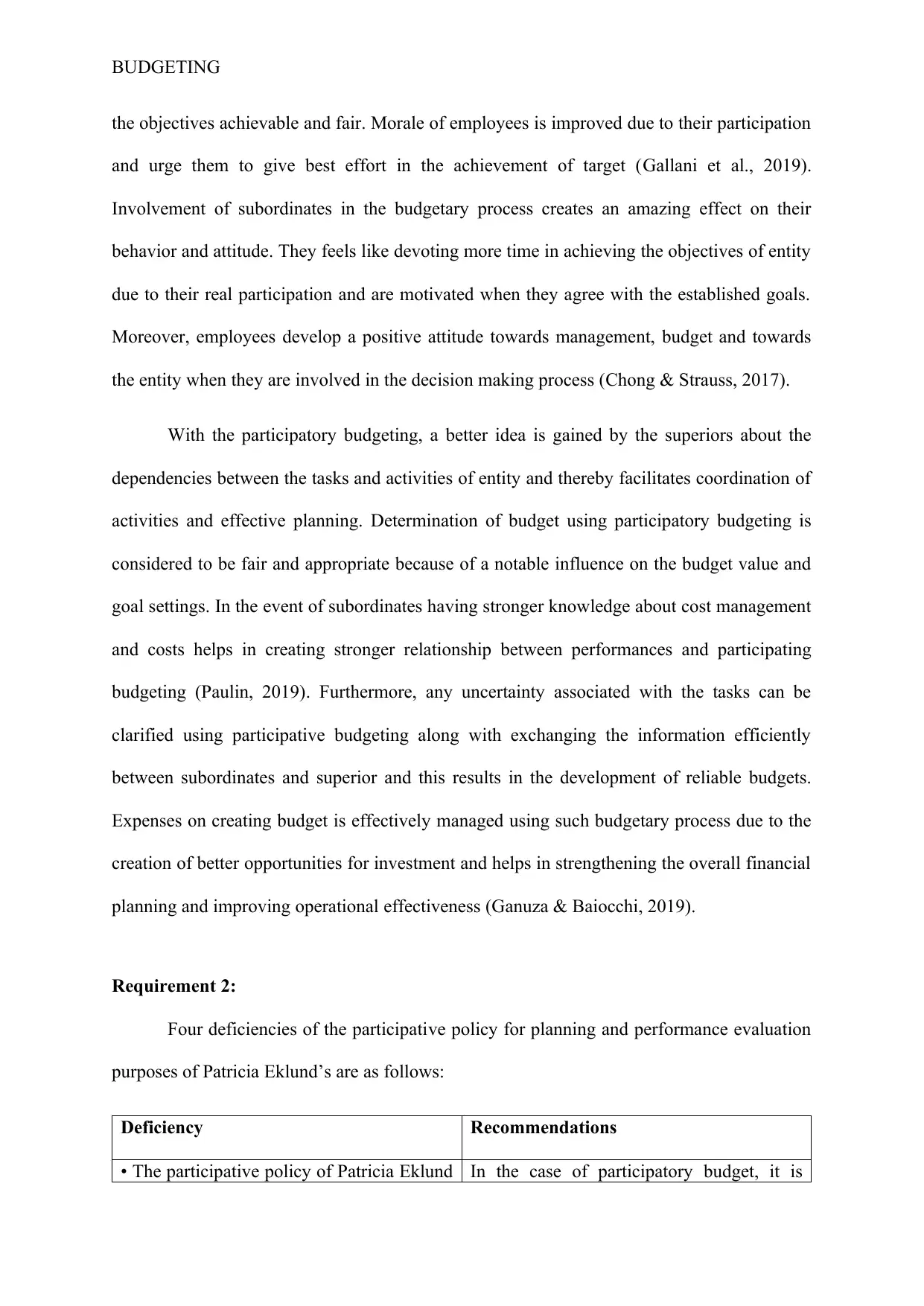
BUDGETING
the objectives achievable and fair. Morale of employees is improved due to their participation
and urge them to give best effort in the achievement of target (Gallani et al., 2019).
Involvement of subordinates in the budgetary process creates an amazing effect on their
behavior and attitude. They feels like devoting more time in achieving the objectives of entity
due to their real participation and are motivated when they agree with the established goals.
Moreover, employees develop a positive attitude towards management, budget and towards
the entity when they are involved in the decision making process (Chong & Strauss, 2017).
With the participatory budgeting, a better idea is gained by the superiors about the
dependencies between the tasks and activities of entity and thereby facilitates coordination of
activities and effective planning. Determination of budget using participatory budgeting is
considered to be fair and appropriate because of a notable influence on the budget value and
goal settings. In the event of subordinates having stronger knowledge about cost management
and costs helps in creating stronger relationship between performances and participating
budgeting (Paulin, 2019). Furthermore, any uncertainty associated with the tasks can be
clarified using participative budgeting along with exchanging the information efficiently
between subordinates and superior and this results in the development of reliable budgets.
Expenses on creating budget is effectively managed using such budgetary process due to the
creation of better opportunities for investment and helps in strengthening the overall financial
planning and improving operational effectiveness (Ganuza & Baiocchi, 2019).
Requirement 2:
Four deficiencies of the participative policy for planning and performance evaluation
purposes of Patricia Eklund’s are as follows:
Deficiency Recommendations
• The participative policy of Patricia Eklund In the case of participatory budget, it is
the objectives achievable and fair. Morale of employees is improved due to their participation
and urge them to give best effort in the achievement of target (Gallani et al., 2019).
Involvement of subordinates in the budgetary process creates an amazing effect on their
behavior and attitude. They feels like devoting more time in achieving the objectives of entity
due to their real participation and are motivated when they agree with the established goals.
Moreover, employees develop a positive attitude towards management, budget and towards
the entity when they are involved in the decision making process (Chong & Strauss, 2017).
With the participatory budgeting, a better idea is gained by the superiors about the
dependencies between the tasks and activities of entity and thereby facilitates coordination of
activities and effective planning. Determination of budget using participatory budgeting is
considered to be fair and appropriate because of a notable influence on the budget value and
goal settings. In the event of subordinates having stronger knowledge about cost management
and costs helps in creating stronger relationship between performances and participating
budgeting (Paulin, 2019). Furthermore, any uncertainty associated with the tasks can be
clarified using participative budgeting along with exchanging the information efficiently
between subordinates and superior and this results in the development of reliable budgets.
Expenses on creating budget is effectively managed using such budgetary process due to the
creation of better opportunities for investment and helps in strengthening the overall financial
planning and improving operational effectiveness (Ganuza & Baiocchi, 2019).
Requirement 2:
Four deficiencies of the participative policy for planning and performance evaluation
purposes of Patricia Eklund’s are as follows:
Deficiency Recommendations
• The participative policy of Patricia Eklund In the case of participatory budget, it is
Paraphrase This Document
Need a fresh take? Get an instant paraphrase of this document with our AI Paraphraser
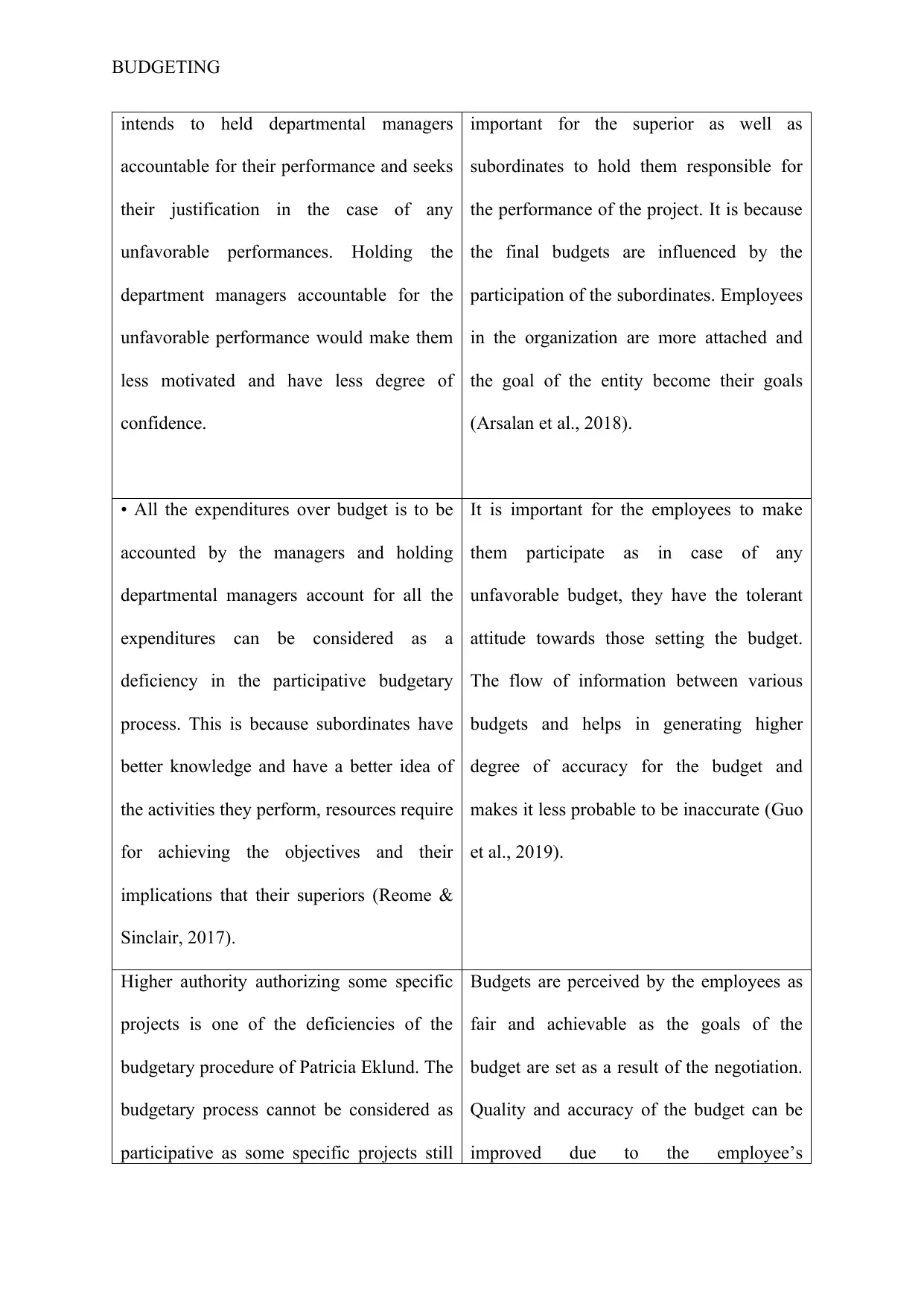
BUDGETING
intends to held departmental managers
accountable for their performance and seeks
their justification in the case of any
unfavorable performances. Holding the
department managers accountable for the
unfavorable performance would make them
less motivated and have less degree of
confidence.
important for the superior as well as
subordinates to hold them responsible for
the performance of the project. It is because
the final budgets are influenced by the
participation of the subordinates. Employees
in the organization are more attached and
the goal of the entity become their goals
(Arsalan et al., 2018).
• All the expenditures over budget is to be
accounted by the managers and holding
departmental managers account for all the
expenditures can be considered as a
deficiency in the participative budgetary
process. This is because subordinates have
better knowledge and have a better idea of
the activities they perform, resources require
for achieving the objectives and their
implications that their superiors (Reome &
Sinclair, 2017).
It is important for the employees to make
them participate as in case of any
unfavorable budget, they have the tolerant
attitude towards those setting the budget.
The flow of information between various
budgets and helps in generating higher
degree of accuracy for the budget and
makes it less probable to be inaccurate (Guo
et al., 2019).
Higher authority authorizing some specific
projects is one of the deficiencies of the
budgetary procedure of Patricia Eklund. The
budgetary process cannot be considered as
participative as some specific projects still
Budgets are perceived by the employees as
fair and achievable as the goals of the
budget are set as a result of the negotiation.
Quality and accuracy of the budget can be
improved due to the employee’s
intends to held departmental managers
accountable for their performance and seeks
their justification in the case of any
unfavorable performances. Holding the
department managers accountable for the
unfavorable performance would make them
less motivated and have less degree of
confidence.
important for the superior as well as
subordinates to hold them responsible for
the performance of the project. It is because
the final budgets are influenced by the
participation of the subordinates. Employees
in the organization are more attached and
the goal of the entity become their goals
(Arsalan et al., 2018).
• All the expenditures over budget is to be
accounted by the managers and holding
departmental managers account for all the
expenditures can be considered as a
deficiency in the participative budgetary
process. This is because subordinates have
better knowledge and have a better idea of
the activities they perform, resources require
for achieving the objectives and their
implications that their superiors (Reome &
Sinclair, 2017).
It is important for the employees to make
them participate as in case of any
unfavorable budget, they have the tolerant
attitude towards those setting the budget.
The flow of information between various
budgets and helps in generating higher
degree of accuracy for the budget and
makes it less probable to be inaccurate (Guo
et al., 2019).
Higher authority authorizing some specific
projects is one of the deficiencies of the
budgetary procedure of Patricia Eklund. The
budgetary process cannot be considered as
participative as some specific projects still
Budgets are perceived by the employees as
fair and achievable as the goals of the
budget are set as a result of the negotiation.
Quality and accuracy of the budget can be
improved due to the employee’s
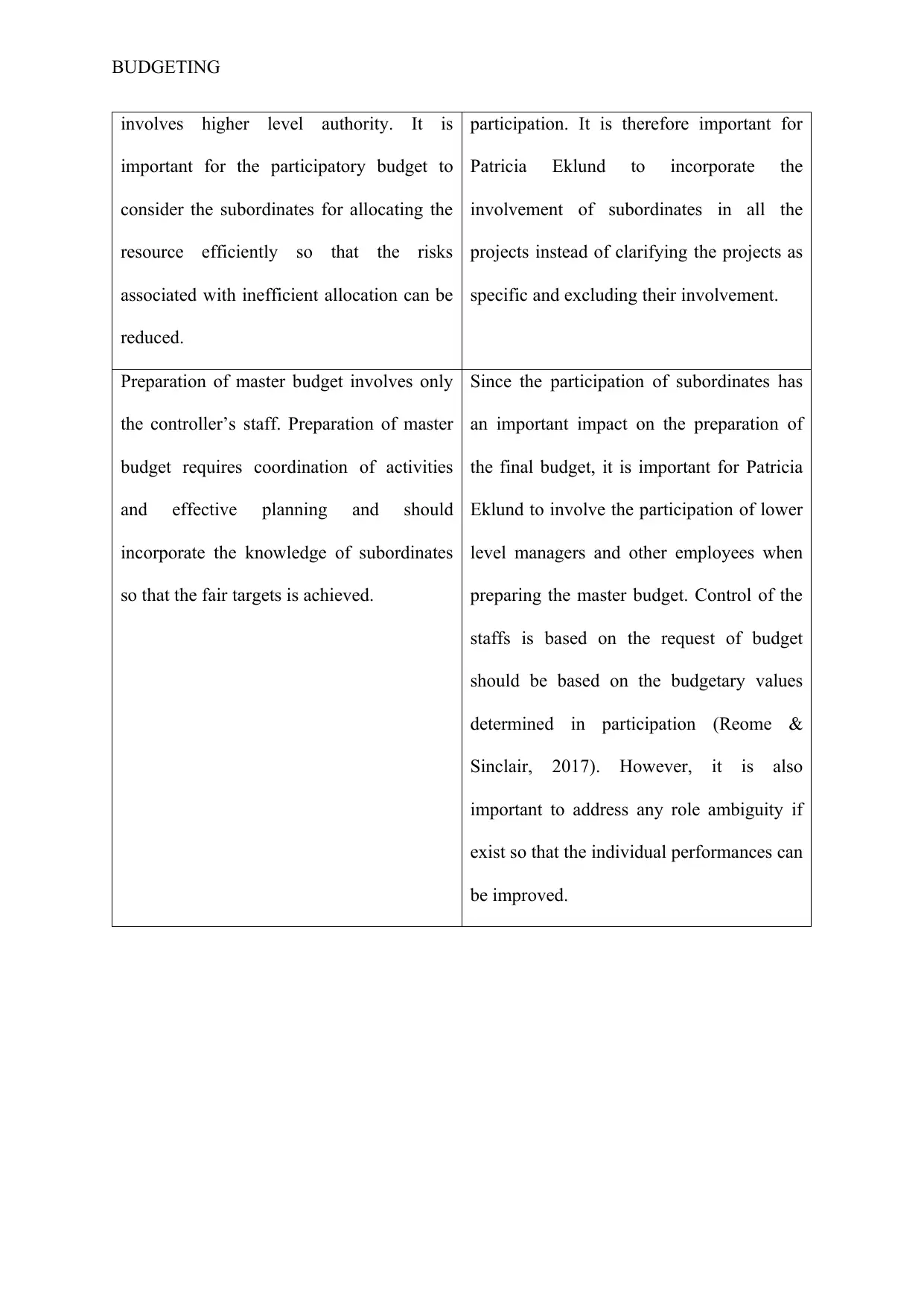
BUDGETING
involves higher level authority. It is
important for the participatory budget to
consider the subordinates for allocating the
resource efficiently so that the risks
associated with inefficient allocation can be
reduced.
participation. It is therefore important for
Patricia Eklund to incorporate the
involvement of subordinates in all the
projects instead of clarifying the projects as
specific and excluding their involvement.
Preparation of master budget involves only
the controller’s staff. Preparation of master
budget requires coordination of activities
and effective planning and should
incorporate the knowledge of subordinates
so that the fair targets is achieved.
Since the participation of subordinates has
an important impact on the preparation of
the final budget, it is important for Patricia
Eklund to involve the participation of lower
level managers and other employees when
preparing the master budget. Control of the
staffs is based on the request of budget
should be based on the budgetary values
determined in participation (Reome &
Sinclair, 2017). However, it is also
important to address any role ambiguity if
exist so that the individual performances can
be improved.
involves higher level authority. It is
important for the participatory budget to
consider the subordinates for allocating the
resource efficiently so that the risks
associated with inefficient allocation can be
reduced.
participation. It is therefore important for
Patricia Eklund to incorporate the
involvement of subordinates in all the
projects instead of clarifying the projects as
specific and excluding their involvement.
Preparation of master budget involves only
the controller’s staff. Preparation of master
budget requires coordination of activities
and effective planning and should
incorporate the knowledge of subordinates
so that the fair targets is achieved.
Since the participation of subordinates has
an important impact on the preparation of
the final budget, it is important for Patricia
Eklund to involve the participation of lower
level managers and other employees when
preparing the master budget. Control of the
staffs is based on the request of budget
should be based on the budgetary values
determined in participation (Reome &
Sinclair, 2017). However, it is also
important to address any role ambiguity if
exist so that the individual performances can
be improved.
⊘ This is a preview!⊘
Do you want full access?
Subscribe today to unlock all pages.

Trusted by 1+ million students worldwide

BUDGETING
References list:
Arsalan, S., Saudi, M. H. M., Susiani, R., & Adison, A. (2018). Effect of Participative
Budgeting, Organizational Commitment and Work Motivation on Managerial
Performance (Survey of Motor Vehicle Dealers in Bandung). International Journal of
Engineering & Technology, 7(4.34), 240-244.
Bogsnes, B. (2016). Implementing beyond budgeting: unlocking the performance potential.
John Wiley & Sons.
Chohan, U. W., & Jacobs, K. (2018). Public value as rhetoric: A budgeting
approach. International Journal of Public Administration, 41(15), 1217-1227.
Chong, V. K., & Strauss, R. (2017). Participative budgeting: The effects of budget emphasis,
information asymmetry and procedural justice on slack–Additional evidence. Asia-
Pacific Management Accounting Journal, 12(1), 181-220.
Gallani, S., Krishnan, R., Marinich, E. J., & Shields, M. D. (2019). Budgeting, psychological
contracts, and budgetary misreporting. Management Science, 65(6), 2924-2945.
Ganuza, E., & Baiocchi, G. (2019). The long journey of participatory budgeting.
In Handbook of Democratic Innovation and Governance. Edward Elgar Publishing.
Guo, L., Libby, T., Liu, X., & Tian, Y. (2019). Vertical Pay Dispersion, Peer Observability,
and Misreporting in a Participative Budgeting Setting. Contemporary Accounting
Research.
Kusuma, B. H. (2017, June). THE INFLUENCE OF BUDGETARY COMMITMENT ON
MANAGERIAL PERFORMANCE: PARTICIPATIVE BUDGETING AS AN
INTERVENING VARIABLE. In The 3rd PIABC (Parahyangan International
Accounting and Business Conference.
References list:
Arsalan, S., Saudi, M. H. M., Susiani, R., & Adison, A. (2018). Effect of Participative
Budgeting, Organizational Commitment and Work Motivation on Managerial
Performance (Survey of Motor Vehicle Dealers in Bandung). International Journal of
Engineering & Technology, 7(4.34), 240-244.
Bogsnes, B. (2016). Implementing beyond budgeting: unlocking the performance potential.
John Wiley & Sons.
Chohan, U. W., & Jacobs, K. (2018). Public value as rhetoric: A budgeting
approach. International Journal of Public Administration, 41(15), 1217-1227.
Chong, V. K., & Strauss, R. (2017). Participative budgeting: The effects of budget emphasis,
information asymmetry and procedural justice on slack–Additional evidence. Asia-
Pacific Management Accounting Journal, 12(1), 181-220.
Gallani, S., Krishnan, R., Marinich, E. J., & Shields, M. D. (2019). Budgeting, psychological
contracts, and budgetary misreporting. Management Science, 65(6), 2924-2945.
Ganuza, E., & Baiocchi, G. (2019). The long journey of participatory budgeting.
In Handbook of Democratic Innovation and Governance. Edward Elgar Publishing.
Guo, L., Libby, T., Liu, X., & Tian, Y. (2019). Vertical Pay Dispersion, Peer Observability,
and Misreporting in a Participative Budgeting Setting. Contemporary Accounting
Research.
Kusuma, B. H. (2017, June). THE INFLUENCE OF BUDGETARY COMMITMENT ON
MANAGERIAL PERFORMANCE: PARTICIPATIVE BUDGETING AS AN
INTERVENING VARIABLE. In The 3rd PIABC (Parahyangan International
Accounting and Business Conference.
Paraphrase This Document
Need a fresh take? Get an instant paraphrase of this document with our AI Paraphraser

BUDGETING
Paulin, A. (2019, June). The Quantum Budget vs. Participatory Budgeting. In Proceedings of
the 20th Annual International Conference on Digital Government Research (pp. 154-
158).
Reome, C., & Sinclair, T. A. (2017). Better Budgeting Is Good Governance. Shared
Governance in Higher Education, Volume 2: New Paradigms, Evolving
Perspectives, 2, 121.
Paulin, A. (2019, June). The Quantum Budget vs. Participatory Budgeting. In Proceedings of
the 20th Annual International Conference on Digital Government Research (pp. 154-
158).
Reome, C., & Sinclair, T. A. (2017). Better Budgeting Is Good Governance. Shared
Governance in Higher Education, Volume 2: New Paradigms, Evolving
Perspectives, 2, 121.
1 out of 11
Related Documents
Your All-in-One AI-Powered Toolkit for Academic Success.
+13062052269
info@desklib.com
Available 24*7 on WhatsApp / Email
![[object Object]](/_next/static/media/star-bottom.7253800d.svg)
Unlock your academic potential
Copyright © 2020–2025 A2Z Services. All Rights Reserved. Developed and managed by ZUCOL.




